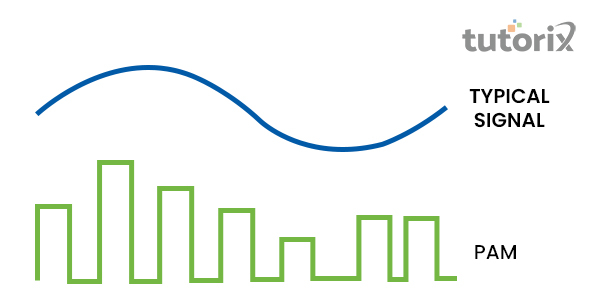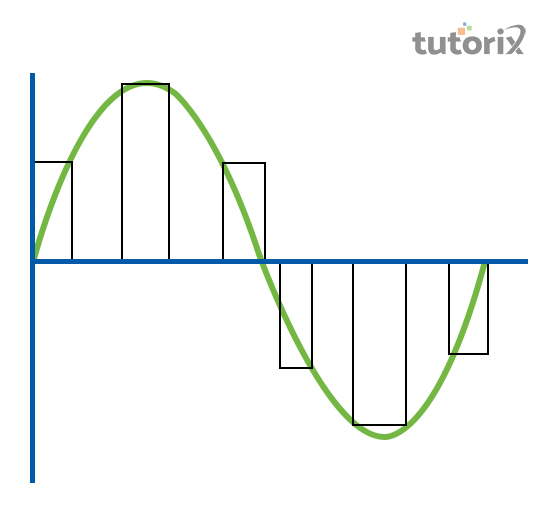Introduction
The Pulse Amplitude Modulation is referred to as a very simple model of signal modulation technique. These are the signals that are further transmitted and are inspected at a very particular interval. On top of it, the modulating signal is proportional directly to the amplitude of the signal
Therefore it general multiple carrier signals like frequency, bandwidth and amplitude which are also its core features. This particular phenomenon is also an outcome because of adding details to the carrier signal in the course of transmission.
What is meant by Pulse Amplitude Modulation (PAM)?

Figure 1: Pam signal
The Pulse amplitude modulation or PAM is denoted as the transmission of data that takes place by changing the amplitudes. Communication has been thoroughly necessary for transmission and this communication occurs through transmitter and receiver with the aid of signals (elprocus, 2022). These signals help carry the information through various modulations. As opined by Khalighi et al. (2017), the aspect of Pulse Amplitude Modulation is one such major type of modulation process that helps in the transmission of signals. This modulation uses an analog to digital signal conversion process; in this case, the information is encoded in the amplitude of signal pulses in a series (stackexchange, 2022). In short Pulse Amplitude Modulation or PAM is used for the conversion of the signal, from analog to a digital version. These signals can be natural and flat top
PAM: types
The Pulse Amplitude Modulation is simply categorized into two distinct sections. This division is done based on the polarity index
- Single polarity PAM − In this case, a proper fixed DC bias is added with a signal that assures that the pulses that are generated through it are positive.
- Double Polarity PAM − : In this type of Pulse Amplitude Modulation where there is a prevalence of two distinct polarities. The DC bias that is added to it propagates both positive and negative pulses
However, it is to be noted that there is a new alteration noticed in the PAM, that is, Pulse Code Modulation and Pulse Position Modulation replaces the non-base band application which results in a much faster transfer of digital data that is in practice in recent times.
The Pulse Amplitude Modulation uses three distinct modulation techniques. These techniques are mentioned as follows
- Pulse Modulation − This aspect is associated with the transmission of signals in pulses (engineersgarage, 2022). These pulses are obtained in either the width type of the pulse or simple Pulse amplitude format
- Continuous Wave modulation − This case of transmission is a property where the carrier signal modulates the the message signal. This transmission occurs because of the fluctuation of amplitude, frequency and change in the phases.
- Digital Modulation − The digital modulation are further classified into two distinct categories. The transmission in this modulation occurs in delta modulation or pulse amplitude modulation
PAM sampling techniques

Figure 2: Flat top Pulse Amplitude modulation
Flat top PAM is one of the crucial sampling techniques where the amplitude of the pulses is proportional to modulating signals amplitude in the occurrence of pulses. In Natural PAM during the occurrence of pulses the modulating signal amplitude is proportional to the amplitude
PAM: Advantages and disadvantages
Advantages
- The circuit of PAM is very easy to make and the relative operation is quite easy as well
- In PAM the transmission is quite easy and fast. The amplitude signal reception experiences zero interference from any external factors
- The Pulse Amplitude Modulation is capable of functioning with two distinct purposes, as this modulation technique can carry various transmitted messages. PAM is also able to produce pulse signals and transmit signals at the same time
- In PAM, the modulation and demodulation happens automatically and it does not demand any sort of manual activity for its functionality
Disadvantages
- Pulse Amplitude Modulation calls for higher bandwidth for the transmission of a signal
- It creates extra noises remnants that cause various disturbances.
- In certain cases, it has been observed that PAM requires a huge volume of power for its functionality
Application of Pulse Amplitude Modulation
- The Pulse Amplitude Modulation is used in various sections.
- It is used in Broadband interface communication for connectivity of the Ethernet.
- It is used in controlling signals of the micro-controllers.
- Pulse Amplitude Modulation is also used in the graphics cards and the associated high-speed networking and it is also useful in the reduction of the noise to signal ratio.
- PAM is also used in photobiology for the usage of spectrofluorimetric measurements during photosynthesis.
- It is also used in LED drivers for efficiency in the energy of the lighting.
- Pulse Amplitude Modulation is also used to obtain clear pictures and proper signal clarity in digital televisions.
Leave a Reply